617 Search Results for tell me about it
October 12, 2013
by Robin Parker -
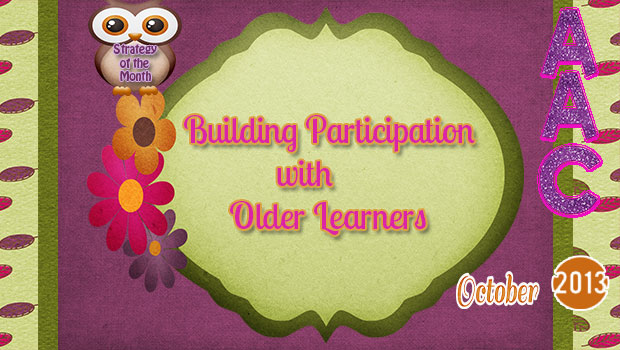
We love active participation for communication and language learning. Actually, we love active participation in all areas of life for us, for our students, for everyone. When Carole introduced the Building Participation Strategy of the Month, she discussed the role of the Participation Model (Beukelman & Mirenda, 1988; 2013). The Participation Model is a framework for understanding the barriers to participation and then from a prAACtical intervention standpoint developing strategies and activities to increase active participation in a variety of (ALL) aspects of life. For the 2012 AAC Awareness Month, we discussed barriers to participation. This year’s focus is on activities and strategies for getting past the barriers to building age appropriate authentic active participation for ALL learners. We have learned that when older learners with significant communication challenges are provided with age appropriate activities and supports, they can be engaged and motivated to participate and can often surprise us with... [Read More...]
October 5, 2013
by Carole Zangari -
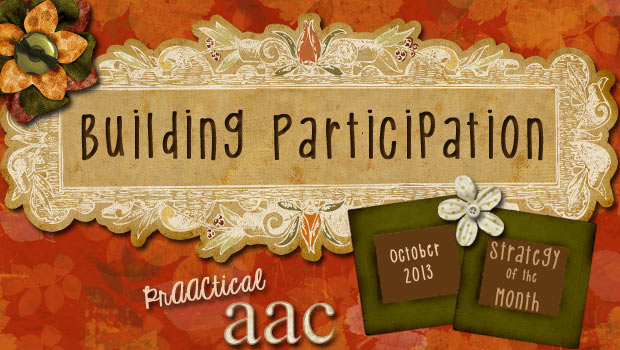
Do you know any of our friends? Jenna can use a talking switch with only a little bit of support. But at calendar time, no one thinks of asking her a question. Hao knows almost two dozen signs and can use a communication wallet with non-signers. But at social gatherings, he’s mostly off to the side playing a game on his iPhone. Isaac uses his SGD capably and can create grammatically correct sentences that include noun phrases and conjunctions. But in Chemistry, his lab group conducts their experiments and writes up the lab report without his contributions. Sienna is able to choose between preferred and non-preferred items in a field of three and is learning to do so in a field of four. But the only time she gets to make a choice is at mealtimes. Like many of you, we put in countless hours helping children and adults who... [Read More...]
September 21, 2013
by Carole Zangari -
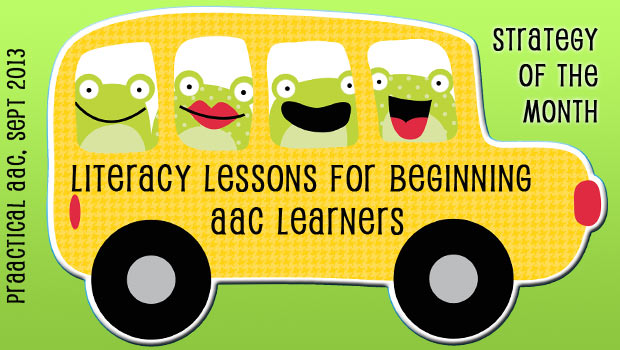
Like some of you, we are often met with skepticism when we encourage teams to work on literacy skills with individuals who are still learning the very basics of communication. Recently, we had the opportunity to begin this journey anew, and model a literacy lesson for kindergartners who have no formal communication system, are not answering yes/no questions, and do not consistently select preferred items when offered choices. Why work on literacy with students who are not routinely expressing their basic preferences? Because the longer we wait, the longer it will take to get there. Because it offers wonderful opportunities to build communication, too. Because when other people see us teaching reading and writing, it changes their perception of the student in a positive way. Because they will enjoy it. Because there are mandates for us to address the general education curriculum. Because if we set the bar high and... [Read More...]
September 19, 2013
by Carole Zangari -
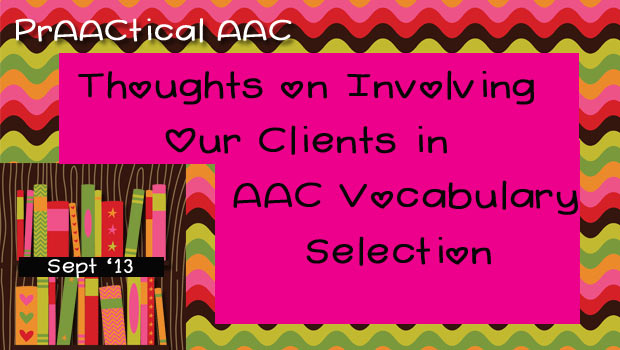
Would you want someone else to pick the car you drive? How happy would you be if someone else selected your wardrobe? How would it feel if the only things you could say were based on words that someone else decided were appropriate for you? Choosing vocabulary is a BIG responsibility. When the client is not fully literate, he/she is constrained to communicating with the words we provide and nothing more. If we left out important concepts, he’s stuck. If we worded the message in a style/tone that doesn’t fit her personality, she’ll be reluctant to use the AAC to communicate. Given this, it makes sense to involve the client in the process of choosing the single words, phrases, sentences, and narratives that we put on the AAC device or in the communication book. If the client is involved, then the messages we end up with are more likely to... [Read More...]
September 18, 2013
by Robin Parker -
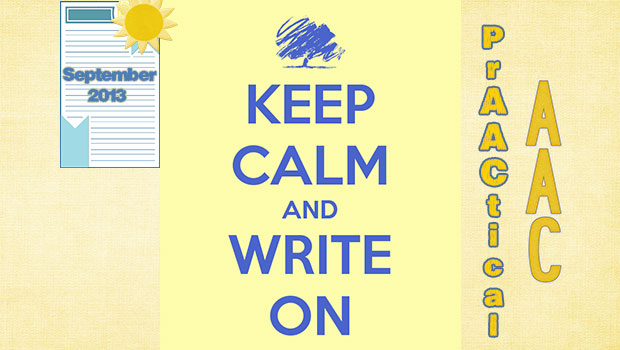
Just like reading, everyone needs opportunities to write. We write to make lists, give notes, tell stories, make signs, write letters, show love, vent, remember things, and much more. All students need lots of writing prAACtice and direct instruction. Here are some (just a few) amazing assistive technology options to help writers at all levels of the writing continuum. Picture Symbol Based Clicker Sentences- For emergent writers, students tap words in a grid to build sentences in a simple word processor. Pictures can be added to further increase comprehension of the sentences. Available as computer software with an evaluation option to try it out free for 30 days as well as in an iOS app Abilipad– A fully customizable keyboard and notepad, with word prediction and text-to-speech. This includes setting up a picture based key board. Check out the Abilipad website for more information about all of the possibilities. Kidspiration Maps– a visual way to mind... [Read More...]
September 16, 2013
by Carole Zangari -
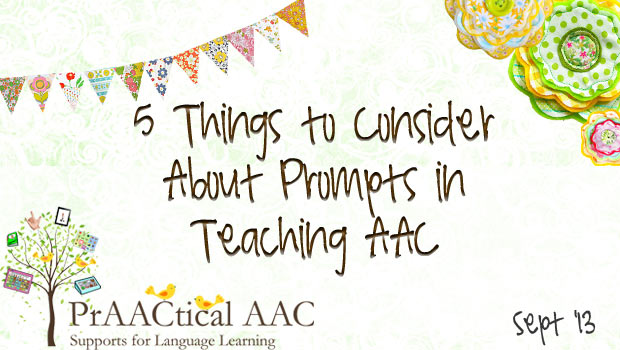
When you’re learning something new, it’s likely that you’ll need some help along the way. The same is true for our AAC learners. Here are some of the things we’ve been thinking about lately regarding prompts and cues. 1. Sometimes, actually MANY times, a ‘perfect pause’ is all that’s needed. Stop the action, look expectantly at the learner, and wait quietly. How long? It depends on the individual and the situation, but 10 or 15 seconds is in the ballpark for most AAC learners. 2. It’s important to consider both the type of prompt (e,g., gestural, verbal, physical) and how much information that prompt provides to the learner. We hear lots of SLPs say that they prefer verbal prompts because they are less helpful than, say a physical prompt, and, thus, require more from learner. Not always. Here’s an example: “Jason, tell me, ‘More milk.’” Vs. Gesturing over the message... [Read More...]
September 14, 2013
by Robin Parker -
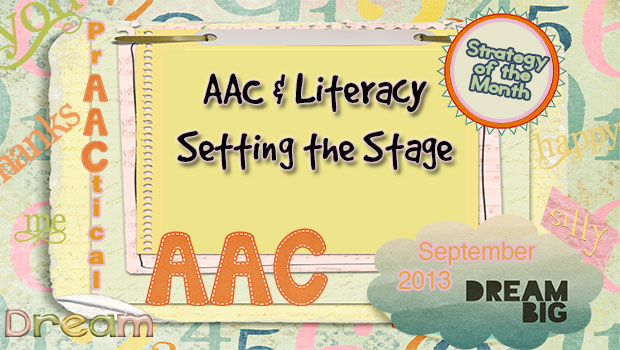
Literacy is for all students. As with most things we learn, emergent readers and writers need to be active participants with print across multiple settings and in multiple meaningful experiences. Emergent readers need to be taught to integrate reading and writing with communication and language. To facilitate this comprehensive integration and understanding, SLP’s and educators can use a variety of authentic research based strategies to help. Create a literacy enriched environment- Literacy skills are promoted through an environment with lots of reading and writing materials. Text based labels and signs will help bring meaning to text in authentic experiences. As you plan activities, include options for writing time/centers, and reading time/centers. Have books accessible to learners. Have lots of book options, but also help students independently turn pages (make it easy with page fluffers), reach books, use writing materials, etc. During interactive activities, give learners a choice of 2 or more books to... [Read More...]
September 13, 2013
by Carole Zangari -
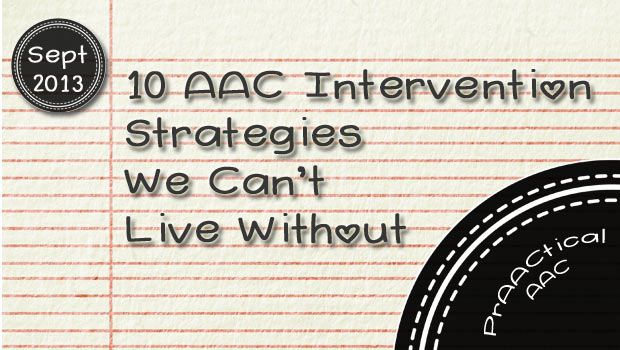
It’s a new semester for us and we’re having lots of conversations with student clinicians about teaching strategies. Here are some of the things they’re putting in their AAC toolkits. Making language visible: Use visual supports to give information, explain, set boundaries, and make expectations clear. Aided language input and focused language stimulation: Teach AAC by speaking AAC. Communication temptations: Make the client want to communicate to get his/her own agenda met Expansions and extensions: The language facilitation strategies we all studied in our language intervention classes work in AAC, too! Repetition with variety: Working on the same thing in different ways is a sure way to build learning and keep treidthings fresh Contrastive examples: Teach through the power of clear examples, both positive AND negative Backward and forward chaining: Great for teaching things that have multiple steps, like sending emails or posting to Facebook Structure: Creating structure helps learner better... [Read More...]
September 12, 2013
by Robin Parker -
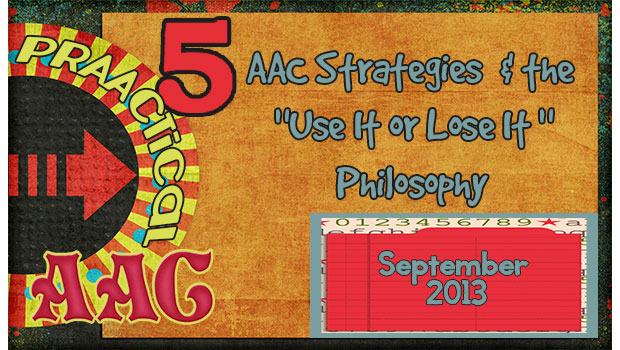
School has begun for almost everyone. Some classes have been in session for a while and routines have been formed, learning is taking place, behaviors have settled down. Now comes what can seem like the hard part: Keeping up with and expanding the strategies that helped students become successful. Instead of trying to fade AAC displays/devices and visual supports, stick with the basics and expand how they can be used. Because if you don’t use it, you may lose it. So: Keep up with: Visual Schedules– monthly, daily, and mini. Even if students know the schedule, continue to use it. Most of us would not like ‘losing’ our day planner or ‘to do’ lists even though we know our schedules. Aided Language Input First- Then Visual Support Visual Boundaries Access to a AAC Display/Device– And the display or device is with the student All the time, everywhere, charged, working, and... [Read More...]
September 10, 2013
by Carole Zangari -
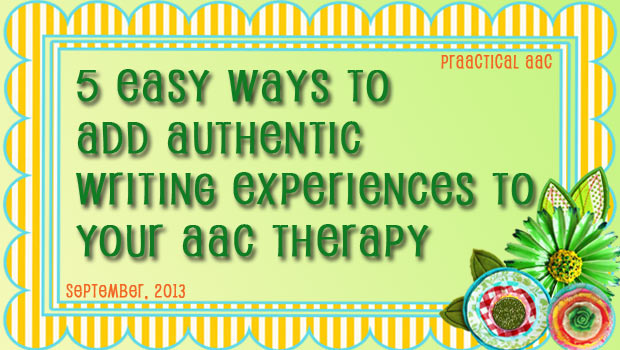
There is no substitute for systematic instruction in reading and writing for building specific skills. AAC learners need high-quality instruction and lots of it. Beyond that, though, there are many ways to infuse literacy practice into the regular routine in therapy and at home. Writing for authentic purposes refers to experiences that reflect the writing activities of people in their regular lives. Authentic writing builds fluency, promotes skill generalization, and helps to build one’s self-concept as a writer. Plus, it’s fun, motivating, and pretty easy to do. Here are some things we try to do to include authentic writing experiences into our AAC therapies. 1. Sign in and out of the therapy session or classroom: Every AAC learner can do this. If the traditional sign-in form then doesn’t cut it, then make up a special sheet that has the client’s name in traceable letters, a name stamp, or placing a... [Read More...]









